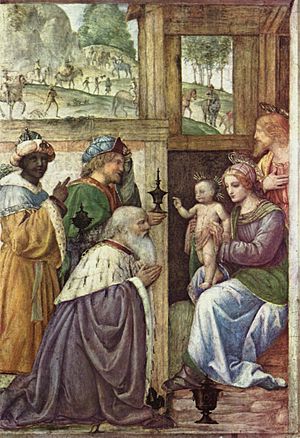Bernardino Luini facts for kids
Quick facts for kids
Bernardino Luini
|
|
|---|---|

Bernardino Luini in a 1851 illustration
|
|
| Born | c. 1480–1482 Runo, Dumenza
|
| Died | June 1532 |
| Nationality | Italian |
| Movement | Italian Renaissance |



Bernardino Luini (born around 1480-1482, died June 1532) was a talented painter from northern Italy. He was part of a group of artists who worked closely with the famous Leonardo da Vinci during the High Renaissance. People said Luini learned a lot from Leonardo, taking in as much as he could. Because of this, some of his paintings were even thought to be by Leonardo himself!
Luini was famous for painting beautiful women with long, graceful eyes. This style was sometimes called 'Luinesque'.
Contents
About Bernardino Luini
Bernardino Luini was born as Bernardino de Scapis in Runo, a small village near Lake Maggiore. We don't know many details about his early life.
In 1500, he moved to Milan with his father. Some art historians believe he trained with Giovan Stefano Scotto. Others think he was a student of Ambrogio Bergognone.
Early Works and Influences
Around 1504-1507, Luini might have been in Treviso. A painting called Madonna with Child from that time is signed by him. His first fresco paintings include Adoration of the Magi in San Pietro of Luino (around 1505). He also painted a fresco in the presbytery of Monza Cathedral.
Luini returned to Milan in 1509. He received a special order for a large painting made of several panels, called a polyptych. Today, only one part of it, St. Anthony of Padua, can be seen in the Museo Poldi Pezzoli.
During the 1510s, he painted many frescoes. These include works in the Oratory of Santa Maria Nuova in Pilastrello and the Abbey of Chiaravalle. He also painted in San Giorgio di Palazzo and the Certosa di Pavia.
Important Commissions
From 1509 to 1514, Luini painted frescoes for the Villa Pelucca in Sesto San Giovanni. These beautiful works are now in the Pinacoteca di Brera in Milan.
One of his most famous works was ordered by Girolamo Rabia. For this person, Luini also painted scenes from old myths in the Palazzo Rabia. These paintings are now in museums like the Berlin Gemäldegalerie and the National Gallery of Art in Washington, D.C.
Later Career and Style
In 1521, Luini traveled to Rome. There, he was influenced by the style of another famous painter, Raphael. You can see this new influence in Luini's later frescoes at the Villa La Pelucca, painted between 1520 and 1523.
In 1523, Luini painted a large polyptych for the Basilica of San Magno, Legnano. It shows the Enthroned Madonna and Child surrounded by Angels.
Around 1525, he finished a series of frescoes about the life of the Virgin and Christ. These are in the sanctuary of Santa Maria dei Miracoli in Saronno. There's a legend that he helped discover the recipe for amaretto cookies while working in Saronno!
Other works from this time include a Holy Family in the Museo del Prado. He also painted two versions of Salome (a famous biblical figure) and a Portrait of a Lady.
In 1529, Luini completed one of his greatest works. This was a large fresco called Passion and Crucifixion at Santa Maria degli Angeli in Lugano. He returned to the Saronno sanctuary in 1531 to finish more frescoes.
Later in his life, Luini was even more influenced by Leonardo da Vinci. You can see this in paintings like St. Anne in the Pinacoteca Ambrosiana.
Bernardino Luini passed away in Milan. His son, Aurelio Luini, also became a skilled painter.
Famous Artworks
Luini created many beautiful paintings and frescoes. Here are some examples of his work:
-
Madonna and Child Enthroned with Angels by Luini's workshop, at the Brooklyn Museum.
-
Ecce Homo, painted around 1500–1530, at the Wallraf-Richartz Museum, Cologne.
-
Christ among Doctors, painted around 1515–1530, at the National Gallery, London.
-
Saint Catherine at the National Art Museum of Azerbaijan, Baku.
- Madonna with Sts Augustine and Margaret, Musée Jacquemart-André, Paris. This painting is signed by Bernardino and dated 1507.
- Virgin, Child, and St. John (around 1510), National Gallery, London. Another version is in the Fogg Art Museum, Boston.
- Madonna Enthroned, abbey of Chiaravalle (around 1512).
- Frescoes from the Cappella di S. Giuseppe, S. Maria della Pace (1518–20). These are now in the Brera Gallery.
- St. Catherine, National Gallery, London. Another version is in the Hermitage, St. Petersburg.
- Salome, Ball State Museum, Indiana.
- Mary and Martha, an oil painting on wood, in a private collection.
- Conversion of Mary Magdalen, San Diego.
- Fresco cycles for the Rabia family (1520–25). Parts of these are now in the Brera, Berlin, and Washington.
- Madonna and Child with St. John, Liechtenstein Collection, Vienna.
- Saint Ambrose (around 1520-22), Museum of the Certosa di Pavia.
- Saint Martin (around 1520-22), Museum of the Certosa di Pavia.
- Female portrait (1521-23), Pavia Civic Museums.
- Frescoes of the Life of Christ and the Life of the Virgin (1525). These are in S. Maria dei Miracoli, Saronno.
- Portrait of a Lady (around 1525) National Gallery of Art, Washington.
- Adoration of the Magi, a detached fresco from 1520-25, in the Musée du Louvre.
- Holy Family with Saints Anne and John the Baptist.
- Flora (around 1515), Sudeley Castle, Gloucestershire.
- "Holy Family with the Infant St John", Museo del Prado, Madrid.
See also
 In Spanish: Bernardino Luini para niños
In Spanish: Bernardino Luini para niños
- Salome with the Head of John the Baptist (Luini)








